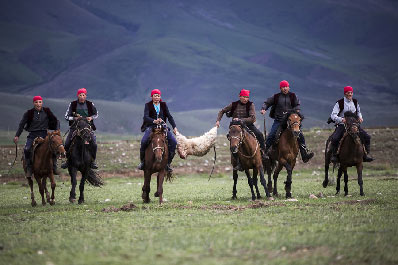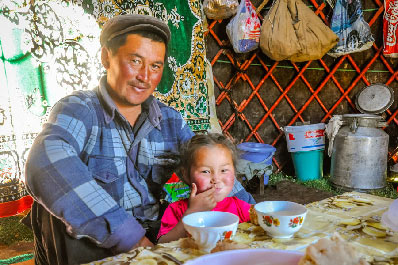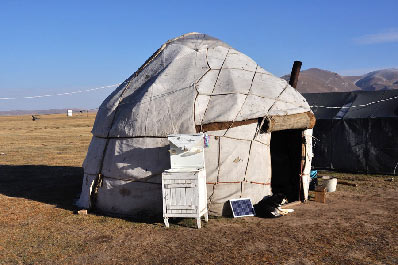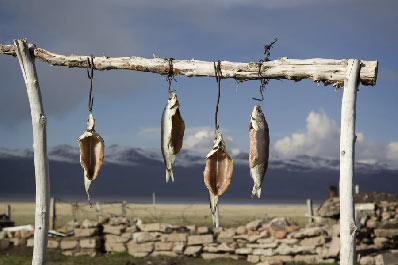Kyrgyzstan Travel Guide
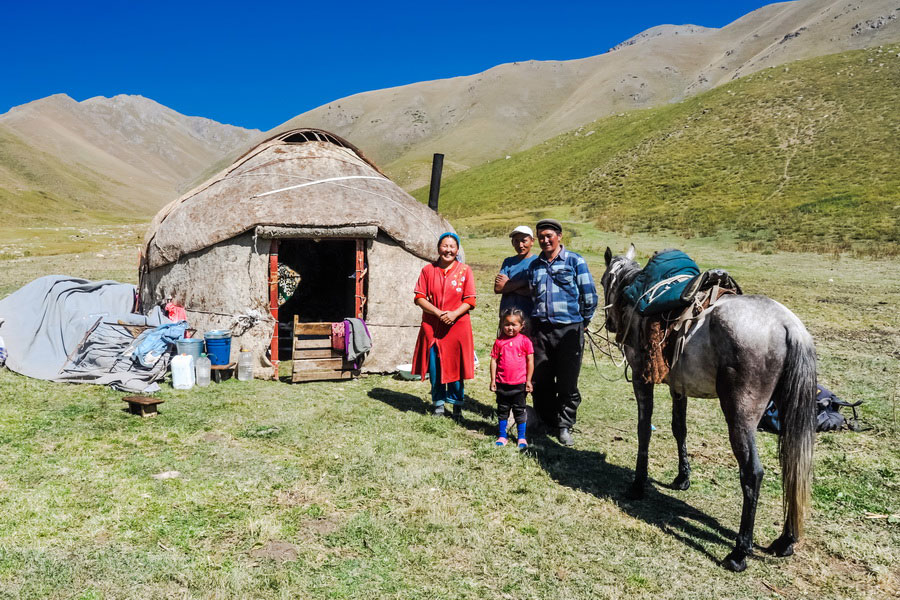
Kyrgyzstan is an exquisitely beautiful country with huge tourism potential: the rugged nomadic culture, endless mountains and lakes, warming hospitality and endless potential for adventure are a combination that draws increasing numbers of tourists each year to this off-the-map little nation.
The Tien Shan and Pamir Mountain ranges wind their way through the territory of Kyrgyzstan and boast of dizzying heights: Pobeda Peak (7439 m), Lenin Peak (7134 m) and Khan Tengri Peak (6995 m), to name a few.
Kyrgyzstan is a great place for extreme sports: climbing, skiing, snowboarding, trekking and hiking. Yet travelers of all types will appreciate the gentle, rugged beauty found in Kyrgyzstan’s sparkling Issyk-Kul Lake, flowering meadows and rolling hills; the historical ruins to be found in the most remote and unexpected of places; and the warm, genuine hospitality of the Kyrgyzstan people.
Check out our Kyrgyzstan travel guide below for answers to the most common questions we hear from travelers planning a trip to Kyrgyzstan.
Kyrgyzstan Travel Guide Topics:
General information about Kyrgyzstan
Capital: Bishkek
Area: 199,900 square kilometers
Population: 7.037 million
Languages: Kyrgyz (official language), Russian (interethnic, in large cities)
Religion: Islam - 82.7%, Christianity - 16%, other faiths - 2%
Electricity: 220V AC, 50 A; standard double plug socket
Time zone: + 6 hours
Internet zone: .kg
International telephone code: +996
Currency: som
How to travel to Kyrgyzstan
The most convenient way to travel to Kyrgyzstan is by air. The Kyrgyzstan capital, Bishkek, is served by several international airlines, and direct flights to Bishkek currently fly in and out of Russia, Turkey, the UAE, Delhi and the surrounding Central Asian nations. The southern city of Osh also has an international airport that can be reached via Dubai, Russia, Kazakhstan, Uzbekistan and Tajikistan.
In addition, there are approximately 12 land border crossings into Kyrgyzstan from its neighboring countries - Uzbekistan, Kazakhstan, China and Tajikistan. Depending upon the crossing, these can be reached by car, bus, train or marshrutka (minivan).
When to visit Kyrgyzstan
The best time of year to travel to Kyrgyzstan really depends on what you wish to see and do.
Ski season in Karakol lasts from mid-November to the end of March, when the whole country experiences a fair amount of snowfall. Keep in mind that during this time of year many mountain passes could also be closed.
Spring is the preferred time to visit for most travelers. It’s a generally mild, colorful time of year when nature comes to life with blooming mountain slopes and pasturelands dotted with horses, sheep and camels.
Unless you’re planning to ski, a trip to the mountains is best planned in July or August, although even in this hot season the mountain air can be cool, with sporadic showers. While summer can be sweltering in the cities, the bazaars are filled with fresh fruits and vegetables, and mountain travel is significantly easier.
The autumn season, apart from scattered rainy days, has cooler weather and gorgeous fall colors, yet a copious amount of fresh produce is still available.
What to wear in Kyrgyzstan
There’s no specific dress code for Kyrgyzstan. In summer you’ll want cool, light clothing, with a couple of warm outfits for your mountain excursions. A hat, sunglasses and trekking shoes are highly recommended.
If you’re visiting in spring or autumn, layered clothing is a good idea, along with a raincoat or umbrella.
Winter travelers will want to bring attire suitable for potentially thick snow and frigid temperatures.
When visiting religious sites, loose clothing that covers your shoulders and knees is recommended (sometimes required for entrance) and women should cover their heads.
When visiting a private home, remove your shoes before entering.
How to get a visa for Kyrgyzstan
Kyrgyzstan is one of the easiest countries to visit in Central Asia. Visa-free entry for an unlimited time is valid for citizens of Armenia, Azerbaijan, Belarus, Cuba, Georgia, Japan, Kazakhstan, Moldova, North Korea, Russia, Tajikistan and Vietnam.
A visa-free regime for up to 60 days is valid for citizens of over 50 countries. Our Kyrgyzstan travel guide offers you more detailed Kyrgyzstan visa information here.
Kyrgyzstan Customs Regulations
The import of alcohol to Kyrgyzstan is limited to 1.5 liters, and cigarettes to 1000 pieces.
Antiques, national artwork and other objects of significant historical, scientific, artistic or cultural value can be exported only with the special permission of the Ministry of Culture of the Republic of Kyrgyzstan and with payment of a customs duty to the amount of 100 percent of the mark indicated on the export permit.
Kyrgyzstan Registration Guidelines
Citizens of 92 countries are exempt from registration in Kyrgyzstan for up to 90 days. Visit our Kyrgyzstan Travel Guide: Visa Requirements Page for a complete list of countries exempt from registration.
Citizens of countries not listed as being exempt from registration on the Kyrgyzstan Visa Requirements Page must register within 5 days after arriving to Kyrgyzstan. Registration can be made at any public service center, and usually your hotel or guest house can easily register you.
Accommodation in Kyrgyzstan
Bishkek has every type of accommodation available: luxury hotels, budget hotels, guest houses, hostels, AirBnB and bed and breakfasts. The popular tourist destinations of Lake Issyk-Kul, Cholpon-Ata and Karakol also boast of a decent selection of guest houses, recreation centers and health resorts for all price ranges.
Kyrgyzstan has the best selection of yurt stays in Central Asia, with the main yurt camps scattered around Son-Kul Lake, Dzhety-Oguz, Tash-Rabat and the southern coast of Lake Issyk-Kul (notably Bel-Tam and Tosor).
Money and Payment in Kyrgyzstan
The official currency of Kyrgyzstan, in which all payments are made in the country, is the Kyrgyz som. Currency exchange can be made at banks, open from 9:00 to 17:00, or in official exchange offices, many which are open around the clock. Exchange rates may vary slightly and in the capital it’s usually higher than in the provinces.
Worn, torn or marked US dollar bills or banknotes will not be accepted for exchange, so if bringing cash into the country with you, we recommend requesting new bills from your bank in higher amounts ($20, $50 or $100).
The use of credit and debit cards is quite limited, but they are accepted at select upscale hotels, restaurants and travel agencies in Bishkek. ATMs are found in Bishkek, Cholpon-Ata and other larger cities and tourist centers. However, as ATMs can often break down, run out of cash or reject your Visa, MasterCard or Maestro, it’s recommended to not wait until the last moment to try and withdraw cash, particularly if you’re outside the capital.
Kyrgyzstan Food
Kyrgyz have long been a nomadic people, and the Kyrgyz national cuisine reflects the need for a nomadic people living in a cold land to have hearty, filling food. Kyrgyz dishes have also been widely influenced by neighboring peoples.
Dishes of lamb, beef, horse meat, onion, potato and dough remain popular throughout the country. You won’t want to leave Kyrgyzstan without trying their most popular dishes:
Beshparmak – thin noodles topped with meat, broth, potatoes, carrots and onions, and traditionally eaten with your right hand.
Manti - dumplings stuffed with a seasoned meat or potato filling and steamed in a special, multi-layered steamer. Manti can sometimes be found stuffed with jusai (a type of green onion) or pumpkin.
Chuchvara – filled with minced meat and onion, these dumplings are much smaller than manti and boiled instead of steamed. Served in broth or separately on a plate and often topped with sour cream.
Ashlyamfu – a Dungan dish found mainly in Karakkol and the Issyk-Kul region, ashlyamfu is a cold soup comprised of rice noodles, vegetables and meat or scrambled eggs.
Laghman – a traditionally Uyghur dish of handmade noodles and well-seasoned meat, peppers and onions. It can be eaten boiled or fried and served in a hot broth or separately on a plate.
Kuurdak – a filling dish of meat, potatoes, oil and onions.
Plov – Although generally less seasoned than Uzbek plov, this rice, carrot and meat dish is common throughout all of Kyrgyzstan.
Samsa - pastries stuffed with meat, potato, pumpkin or cheese and baked in a clay oven, samsas are a cheap and tasty street food.
Shashlyk – meat kebabs made from chicken, beef, ground beef, lamb or liver.
Bishkek also has a good selection of international cuisine, including Italian, American, Indian, Pakistani and Chinese restaurants.
Vegetarian options: Although Kyrgyz love their meat, vegetarian options include salads, bread and milk products, or manti and samsas stuffed with pumpkin or potato. Vegetarian options are also available in many of the international cafes in the capital.
Popular local drinks include kumis (sour mare’s milk), maksym (sour wheat drink), bozo (mildly fermented millet drink) and local beers and cognac.
Internet and Phone Service in Kyrgyzstan
There are several mobile operators in Kyrgyzstan, the largest of which are Beeline, O! and Megakom. Beeline has the largest coverage in the country, Megacom the best prices in relation to the coverage provided, and O! the cheapest overall prices and access to 4G.
SIM cards can be obtained at each company’s official stores and at some of the street kiosks. They usually cost around $2, and 1-2-week plans are also offered. You may be asked to show your passport upon purchase, particularly in the official stores.
Wi-Fi is available at many cafés and coffee shops in the capital but is harder to find the farther you go from Bishkek. Kyrgyzstan is less restrictive than its neighbors but accessing the internet through a reliable VPN, while not necessary, is still recommended.
Kyrgyzstan Healthcare
Travel to Kyrgyzstan does not require any specific vaccinations, but it’s a good idea to be up to date on your immunizations. While most medications (or their Russian variant) can be easily found in country and bought without a prescription, it’s a good idea to bring your standard first-aid kit of essential medications and basic first-aid items. If you plan to bring prescription medications, you’re required to declare them upon entry and exit and to have a doctor's prescription with you, although the likelihood of them checking your medications at customs is quite small.
Internationally accredited healthcare is available in Bishkek, but not outside of the capital. Tap water is safe to drink throughout the country. The most common concerns faced by travelers to Kyrgyzstan include digestive issues from unwashed produce and heavy foods, and difficult mountain passes made worse by impatient drivers and unexpected potholes.
Is Kyrgyzstan Safe?
Kyrgyzstan is generally a safe country to visit, although travelers should still exercise caution around the border areas. Ethnic tensions continue in the Osh region, and occasional political demonstrations have been held in downtown Bishkek, particularly around Ala-Too Square. Although there have been violent altercations in these areas, they are a rare occurrence.
Beware of petty theft, pickpocketing and scam artists, particularly late at night and in crowded or tourist-heavy areas, such as the bazaars. Violent crimes are much less common, but travelers should be particularly vigilant at night or when traveling alone.
If you’re planning a trek to the mountains, bear in mind the possibility of altitude sickness and take the necessary precautions of packing adequate supplies and warm clothing.
Kyrgyzstan Souvenirs and Gifts
The memory of warm Issyk-Kul, historical monuments, ancient petroglyphs and towering mountain landscapes can be preserved not only in the heart, but also with interesting souvenirs from Kyrgyzstan.
Felt products are quintessentially Kyrgyz and very easy to transport home. Felt hats, slippers, carpets, bags, clothing and accessories, decorated with traditional Kyrgyz motifs, make great gifts. Items made of bone are also popular among tourists, including figurines, key rings, and knives.
Other great gift ideas include dolls in colorful national dresses, genuine leather products, dishes stamped with national patterns and various hand-carved kitchen utensils.
Leaving Kyrgyzstan
For an international flight, we recommend arriving at the airport a couple of hours before your departure. You cannot export perishable food products, unprocessed metals or minerals from Kyrgyzstan.
When passing through customs, you may also be asked to show them the souvenirs you’ve purchased to ensure that you’re not illegally exporting antiques or items of cultural value.

